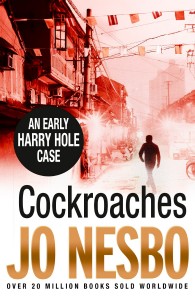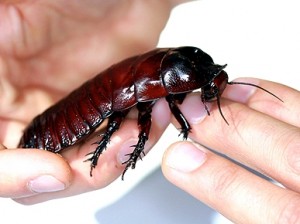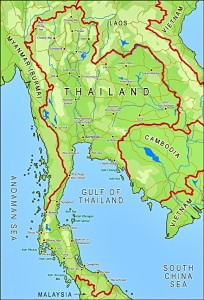“He saw something move in the gloom, on the sink, a couple of antennae swinging to and fro. A cockroach. It was the size of a thumb…He shivered. It was cold comfort knowing they were more frightened than he was. Sometimes he had the feeling alcohol had done him more good than harm. He closed his eyes and tried not to think.” Harry Hole, after his first day in Bangkok.
 English speakers were first introduced to the work of Norwegian author Jo Nesbo and his damaged main character Harry Hole, in 2006, with the publication of The Redbreast, the third book in the Harry Hole series, a novel so good that it won the Norwegian Booksellers Prize for Best Novel of the Year in 2000, when it was published in Norway. In 2004, it also won the award for Best Norwegian Crime Novel Ever Written, as chosen by Norwegian Book Clubs. The eight novels in the series written since The Redbreast have been published consecutively through 2011, and show Nesbo’s increasing skill manipulating more complex characters, more daring plot lines, and a variety of genres (from historical mystery through the most horrific of horror). In 2012, however, Nesbo’s first novel, The Bat, released in Norway in 1997, was suddenly released for English speakers, shortly after the publication of Phantom, one of Nesbo’s best new novels,. The Bat, too, was a prize-winner when it was first written, though Nesbo was obviously a much less accomplished writer fifteen years ago. The publication of this early novel provided fun for Nesbo’s many long-time fans, and suggests some of the excitement that was to evolve further in his later novels.
English speakers were first introduced to the work of Norwegian author Jo Nesbo and his damaged main character Harry Hole, in 2006, with the publication of The Redbreast, the third book in the Harry Hole series, a novel so good that it won the Norwegian Booksellers Prize for Best Novel of the Year in 2000, when it was published in Norway. In 2004, it also won the award for Best Norwegian Crime Novel Ever Written, as chosen by Norwegian Book Clubs. The eight novels in the series written since The Redbreast have been published consecutively through 2011, and show Nesbo’s increasing skill manipulating more complex characters, more daring plot lines, and a variety of genres (from historical mystery through the most horrific of horror). In 2012, however, Nesbo’s first novel, The Bat, released in Norway in 1997, was suddenly released for English speakers, shortly after the publication of Phantom, one of Nesbo’s best new novels,. The Bat, too, was a prize-winner when it was first written, though Nesbo was obviously a much less accomplished writer fifteen years ago. The publication of this early novel provided fun for Nesbo’s many long-time fans, and suggests some of the excitement that was to evolve further in his later novels.
Now, following another of Nesbo’s most exciting novels, Police (the sequel to Phantom), comes the English language release of Cockroaches, originally published in Norway in 1998, the second in the Harry Hole series. This novel has won no prizes, however, and those who read it, as I did, in the hope of seeing the continuing development of an author who made a quantum leap from his fairly simple first two novels (The Bat, and Cockroaches) to the complex and superbly developed novel The Redbreast, his outstanding third novel, may be disappointed by this novel’s consistent lack of clear focus. In Cockroaches, Detective Harry Hole is chosen by the Norwegian Foreign Office to go to Thailand to investigate the murder of Norway’s ambassador to Thailand, who has been found in a brothel with an elaborate old knife in his back.
Hole himself is a psychological mess, an alcoholic trying to stay sober, and a man who caused a death during his youth and still feels guilt for it. He also grieves for his sister, a Down Syndrome child, who was raped and impregnated, and he blames himself for not being able to solve that case, which has now been closed. He has no interest in going to Thailand, even for a short time, to investigate this murder, under the aegis of the foreign office, and he suspects that he has been chosen because they expect him to fail so that the foreign office can close the case without revealing details publicly. The victim, Ambassador Atle Molnes, is a crony of the Norwegian Prime Minister, and the nature of his murder would be embarrassing to the foreign office and the Norwegian government. Hole, smart enough to realize this before he leaves, makes a deal with the head of the Oslo police department that if he goes to Thailand for one week to work on this case that he will be given access to the files in his sister’s case, in return.
In Bangkok, Harry gets started on the case and quickly discovers that the ambassador was a practitioner of many perversions, which extended beyond the “normal” prostitution, rampant in Bangkok, to paedophilia and child pornography. The knife used to kill him belonged to the most powerful heroin dealer in history, who now finances most of the new hotels in Burma and manages the opium trade in the north of Thailand. In addition, the ambassador is indebted to loan sharks, and trailed by their goons, as a result of his gambling addiction. By the time the novel reaches page one hundred, a large number of characters and an equally large number of criminal enterprises and perversions have been mentioned as the investigation of the ambassador’s murder goes off in many different directions. The purpose of all these disparate threads in the structure of the novel is unclear, and the descriptions of their crimes often become tedious.

Gigantic roach, about the size of a thumb, which some people enjoy as pets. Photo by Cameron Richardson/Newspix/Rex/USA
The ambassador’s personal relationships, presumably with numerous lovers, add yet another level of complication, and suggest both blackmail and resulting political problems for the ruling Christian Democrats in Norway, should the ambassador’s secret lives become public. Eventually, even currency trading and the bankruptcy of a major firm have their moments in the spotlight. Additional grisly murders take place as the novel progresses, but they are presented primarily through talk and not through action scenes, leaving the novel with surprisingly little drama, lacking the kind of tension which has made the other Harry Hole novels so compelling. As more and more threads take Harry in still more directions, the reader quickly becomes as frustrated as the detective, since there are few, if any, real connections which would draw the reader into all the threads and create interest in all the characters. Mistaken identity, betrayals, and surprise revelations do create suspense, but part of that suspense lies in to trying to figure out how Harry Hole is going to make sense of this whole, complicated mess.
Jo Nesbo’s fine sense of drama, honed to razor sharpness in his later novels, is enhanced in those novels by Nesbo’s development of sympathetic characters (or at least interesting ones). As the series develops and characters repeat throughout, the reader comes to know Harry Hole, with all his weaknesses, and the many other characters with whom he associates, both within the police department and in the Oslo community. Readers who have enjoyed the later novels may be surprised by Cockroaches, which shows little about Harry himself and even less about the secondary characters. Those who have read all the other Harry Hole novels, however, will probably also read this one, for the sake of “completion,” if nothing else. Those new to the series may want to begin with The Redbreast, certainly one of the best of the series, and then read the others in the series in the order in which they were published (see Wikipedia). Both The Bat and Cockroaches will be of primary interest to those who have already finished all the other books in the series.
ALSO by Jo Nesbo (See Wikipedia for order of release): THE BAT, THE REDBREAST, NEMESIS, THE DEVIL’S STAR, THE REDEEMER, THE SNOWMAN, THE LEOPARD, PHANTOM, POLICE, THE SON (2014), BLOOD ON SNOW (2015), MIDNIGHT SUN (2016), THE THIRST (2017, KNIFE (2019)
Photos, in order: The author’s photo may be found on http://www.zimbio.com/
The Norwegian Embassy in Bangkok may be seen here: http://www.emb-norway.or.th/
One of the world’s largest species of roaches, this one is the size of a thumb, often sold as a pet in Asia and Australia: http://www.peoplepets.com Photo by Cameron Richardson/Newspix/Rex/USA
The map of Thailand and its neighbors is from http://www.visit-thailand.info/information/map-of-thailand.htm



